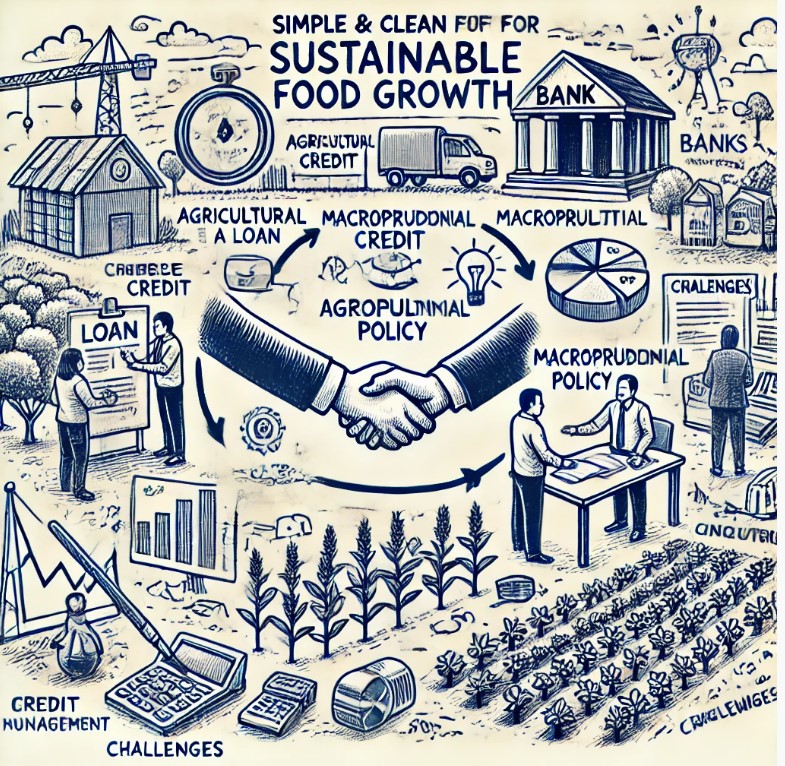
Warnamediaonline.com-16/06/2024. Imagine agricultural credit as the fuel that drives the engine of food production. Just as gasoline makes a car run, credit allows farmers to purchase seeds, fertilizers, and tools they need. However, just like fuel needs to be used wisely to keep the engine in good condition, credit must also be managed properly to avoid problems down the road. This is where macroprudential policies play a crucial role, ensuring the financial system remains stable and sustainable.
Classical Economic Theory on Agricultural Credit
According to classical economic theory, agricultural credit should act as a catalyst for growth in the food sector. The theory is simple:
- Increasing Investment: Like buying better fertilizers and seeds to yield a bigger harvest.
- Facilitating Technology: Credit enables farmers to adopt new technologies, such as tractors or modern irrigation systems, that improve efficiency and production yields.
- Encouraging Diversification: With access to credit, farmers can plant various crops, reducing the risk of crop failure and increasing income.
Empirical Findings: Reality on the Ground
However, reality often differs from theory. Just like an engine that can break down if not properly maintained, poorly managed credit can cause problems:
- Over-Indebtedness: Excessive credit can lead to farmers being burdened with debt, reducing their ability to invest and grow. This is like overfilling a gas tank until it overflows and damages the engine.
- Misallocation of Funds: Poorly managed credit can be used for non-productive purposes, reducing its positive impact on productivity. This is like using gasoline for unnecessary purposes, wasting resources.
- Economic Shocks: Commodity price fluctuations and climate changes can disrupt farmers’ ability to repay loans, causing financial instability. It’s like a bumpy road making it hard for a car to drive smoothly.
The Role of Macroprudential Policies
Macroprudential policies are like mechanics that keep the engine running smoothly. These policies maintain the stability of the financial system by managing systemic risks that can affect the agricultural sector:
- Credit Supervision: Regulating credit distribution to avoid over-indebtedness and ensure credit is used for productive purposes. It’s like ensuring the right amount of fuel is used to keep the engine running efficiently.
- Risk Diversification: Encouraging diverse sources of financing, including Islamic financing and venture capital, to reduce reliance on a single type of credit. This is like having various types of backup fuel to anticipate if one type runs out.
- Risk Management: Developing risk management mechanisms to protect farmers from price fluctuations and other risks. This is like installing safety systems in a car to keep it stable on rocky roads.
Synergy between Agricultural Credit and Macroprudential Policies
To maximize the benefits of agricultural credit, a synergy between agricultural credit and macroprudential policies is needed:
- Integrated Financial Support: The combination of foreign investment, agricultural credit from general banks, and macroprudential policies can provide more comprehensive financial support for the food sector. It’s like maintaining an engine with a combination of lubricants, quality fuel, and regular maintenance.
- Increased Access to Capital: Macroprudential policies can increase access to foreign and domestic capital, while agricultural credit provides the local financing needed for daily operations. This is like having various fuel sources to ensure the engine keeps running.
- Risk Mitigation: With strong macroprudential policies, risks associated with foreign investment and agricultural credit can be minimized, especially in terms of market volatility and macroeconomic risks. This is like having anti-lock brakes (ABS) to avoid skidding on slippery roads.
- Local Capacity Building: Macroprudential policies enable local farmers to enhance their production capacity to leverage technology and capital brought by foreign investors. This is like upgrading a car engine to be stronger and more efficient.
Strategies for Managing Agricultural Credit with Macroprudential Policies
To maximize the benefits of agricultural credit in the long term, the following strategies can be applied:
- Education and Training: Providing education and training to farmers on financial management and effective credit use. This is like giving driving lessons so drivers can maintain and operate their cars properly.
- Financial Infrastructure Improvement: Developing financial infrastructure that supports efficient and transparent credit distribution and implementing appropriate macroprudential policies. This is like building a network of gas stations spread across various locations to ensure an uninterrupted fuel supply.
- Diversification of Financing Sources: Reducing reliance on a single type of credit by offering various financing options, including Islamic financing and venture capital. This is like having several types of alternative fuels to ensure the car keeps running under various conditions.
- Risk Management: Developing risk management mechanisms to protect farmers from price fluctuations and other risks, supported by macroprudential policies. This is like installing advanced safety features in a car to protect the driver from accidents.
Conclusion
Although classical economic theory states that increasing agricultural credit should boost productivity and growth in the food sector, real-world outcomes are more varied. In the long term, the effectiveness of agricultural credit is greatly influenced by good management, financial infrastructure, and strong macroprudential policies.
With the right strategies and support from macroprudential policies, agricultural credit can be a powerful tool to drive growth in the food sector, increase productivity, and support farmers’ welfare. The government and financial institutions need to collaborate to create an environment conducive to effective and sustainable credit use. Like maintaining a car engine to keep it running well, agricultural credit and macroprudential policies must work together to ensure Indonesia’s agriculture continues to grow and thrive.
Policy Brief: Managing Agricultural Credit for Sustainable Food Growth in Indonesia
Executive Summary
Agricultural credit plays a crucial role in providing the capital needed for investment and daily operations in the food sector. However, reality shows that the management of agricultural credit often does not align with classical economic theory, especially in the long term. Macroprudential policies can play an important role in maintaining financial stability and ensuring agricultural sustainability. With the right strategies, agricultural credit can be an effective tool to drive growth in the food sector, increase productivity, and support farmers’ welfare.
Background
The agricultural sector is the backbone of Indonesia’s economy, providing employment for the majority of the population and contributing significantly to GDP. Agricultural credit provides the necessary capital to increase productivity through investment in production inputs, technology, and business diversification. However, empirical findings show that agricultural credit often poses challenges such as over-indebtedness, misallocation of funds, and vulnerability to economic shocks.
Challenges
- Over-Indebtedness: Excessive credit can lead to farmers accumulating debt, reducing their ability to invest and grow.
- Misallocation of Funds: Poorly managed credit can be used for non-productive purposes, reducing its positive impact on productivity.
- Economic Shocks: Commodity price fluctuations and climate change can disrupt farmers’ ability to repay loans, causing financial instability.
Role of Macroprudential Policies
Macroprudential policies are designed to maintain financial system stability by managing systemic risks that can affect the agricultural sector. Some ways these policies can support agricultural credit are:
- Credit Supervision: Strict regulation of agricultural credit distribution to prevent over-indebtedness and ensure credit is used for productive purposes.
- Risk Diversification: Encouraging diversification of financing sources, including Islamic financing and venture capital, to reduce reliance on a single type of credit.
- Risk Management: Developing risk management mechanisms to protect farmers from price fluctuations and other risks.
Synergy between Agricultural Credit and Macroprudential Policies
To maximize the benefits of agricultural credit, synergy between agricultural credit and macroprudential policies is needed:
- Integrated Financial Support: The combination of foreign investment, agricultural credit from general banks, and macroprudential policies can provide more comprehensive financial support for the food sector.
- Increased Access to Capital: Macroprudential policies can increase access to foreign and domestic capital, while agricultural credit provides the local financing needed for daily operations.
- Risk Mitigation: With strong macroprudential policies, risks associated with foreign investment and agricultural credit can be minimized, especially in terms of market volatility and macroeconomic risks.
- Local Capacity Building: Macroprudential policies enable local farmers to enhance their production capacity to leverage technology and capital brought by foreign investors.
Strategies for Managing Agricultural Credit with Macroprudential Policies
To maximize the benefits of agricultural credit in the long term, the following strategies can be applied:
- Education and Training: Providing education and training to farmers on financial management and effective credit use.
- Financial Infrastructure Improvement: Developing financial infrastructure that supports efficient and transparent credit distribution, and implementing appropriate macroprudential policies.
- Diversification of Financing Sources: Reducing reliance on a single type of credit by offering various financing options, including Islamic financing and venture capital.
- Risk Management: Developing risk management mechanisms to protect farmers from price fluctuations and other risks, supported by macroprudential policies.
Conclusion
Agricultural credit, if well managed and supported by strong macroprudential policies, can be a powerful tool to drive growth in the food sector, increase productivity, and support farmers’ welfare. The government and financial institutions need to collaborate to create an environment conducive to effective and sustainable credit use. This holistic approach ensures that all parts of the agricultural sector receive the attention needed for long-term resilience and prosperity.
Author : Dudi Duta Akbar. https://orcid.org/0000-0002-2458-769X






